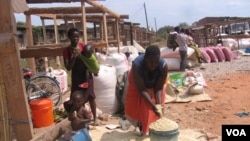Scientists and food experts have high hopes in achieving global food security as the Cinsultatvie Group on Internnational Agricultural Research (CGIAR) recently announced a billion-dollar funding milestone.
The world’s largest agriculture research partnership says funding for research and development went from $500 million dollars in 2008 to $1 billion dollars in 2013.
CGIAR partners around the world conduct research to reduce poverty in rural areas to overcome complex challenges in areas such as climate change, water scarcity, land degradation and chronic malnutrition. The new funding allows the consortium to expand their focus on their 16 global research programs in developing policies and technologies.
The increased funding has also allows the partnership to commit to providing 12 million African households with sustainable irrigation; saving 1.7 million hectares of forest from destruction; and providing 50 million poor people with access to highly nutritious food crops. Two major crops that have already been improved upon due to expanded research are maize and rice.
“Results of those changes, for example, have allowed for a large expansion in the work on drought tolerant maize, particularly in Africa, and in Asia on flood tolerant rice, where the fruits of research have gotten into the hands of farmers in a very, very rapid way,” says Jonathan Wadsworth, executive secretary of the CGIAR Fund Council.
He uses rice as an example. Four years after the release of new types of rice that withstand temporary flooding in Asia, he said over four million farm families are reaping the benefits.
“In Africa, on drought tolerant maize, hundreds of thousands of farmers are now using varieties which give them a harvest even in times of drought,” says Wadsworth.
In severe drought conditions of sub-Saharan Africa and in the Sahel region, agroforestry is being incorporated into the production of maize production.
In looking ahead into the year 2014, Wadsworth sees challenges throughout the agriculture production cycle. However, scientists are already meeting these challenges head on.
“I think one thing which we have shown in the CGIAR is that food security is not only a question of the amount of food, it’s also to do with the quality of the food which is produced and available both to rural households, and to urban population," he explains.
He points out that one of the areas that CGIAR has been developing over the last few years and will expand on this year is increasing the nutritional value of staple crops to ensure higher levels of protein, micro-nutrients, and vitamins that are essential to the health of the population, particularly for pregnant and lactating women, and children.
He highlights new research done in Latin America that has yielded new types of sweet potato. Now more nutrient-enriched, this crop has been introduced in Africa, and the high levels of vitamin A in the sweet potato will improve the vitamin A deficient diets in many African countries.
The world’s largest agriculture research partnership says funding for research and development went from $500 million dollars in 2008 to $1 billion dollars in 2013.
CGIAR partners around the world conduct research to reduce poverty in rural areas to overcome complex challenges in areas such as climate change, water scarcity, land degradation and chronic malnutrition. The new funding allows the consortium to expand their focus on their 16 global research programs in developing policies and technologies.
The increased funding has also allows the partnership to commit to providing 12 million African households with sustainable irrigation; saving 1.7 million hectares of forest from destruction; and providing 50 million poor people with access to highly nutritious food crops. Two major crops that have already been improved upon due to expanded research are maize and rice.
“Results of those changes, for example, have allowed for a large expansion in the work on drought tolerant maize, particularly in Africa, and in Asia on flood tolerant rice, where the fruits of research have gotten into the hands of farmers in a very, very rapid way,” says Jonathan Wadsworth, executive secretary of the CGIAR Fund Council.
He uses rice as an example. Four years after the release of new types of rice that withstand temporary flooding in Asia, he said over four million farm families are reaping the benefits.
“In Africa, on drought tolerant maize, hundreds of thousands of farmers are now using varieties which give them a harvest even in times of drought,” says Wadsworth.
In severe drought conditions of sub-Saharan Africa and in the Sahel region, agroforestry is being incorporated into the production of maize production.
In looking ahead into the year 2014, Wadsworth sees challenges throughout the agriculture production cycle. However, scientists are already meeting these challenges head on.
“I think one thing which we have shown in the CGIAR is that food security is not only a question of the amount of food, it’s also to do with the quality of the food which is produced and available both to rural households, and to urban population," he explains.
He points out that one of the areas that CGIAR has been developing over the last few years and will expand on this year is increasing the nutritional value of staple crops to ensure higher levels of protein, micro-nutrients, and vitamins that are essential to the health of the population, particularly for pregnant and lactating women, and children.
He highlights new research done in Latin America that has yielded new types of sweet potato. Now more nutrient-enriched, this crop has been introduced in Africa, and the high levels of vitamin A in the sweet potato will improve the vitamin A deficient diets in many African countries.









